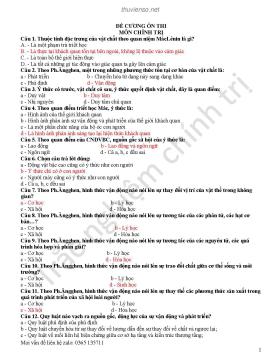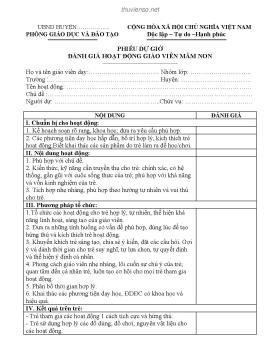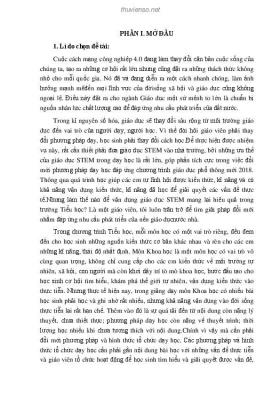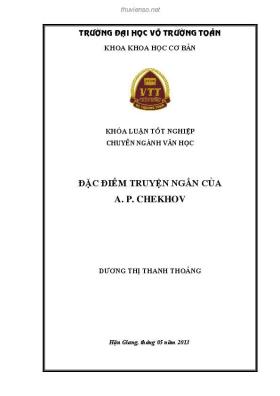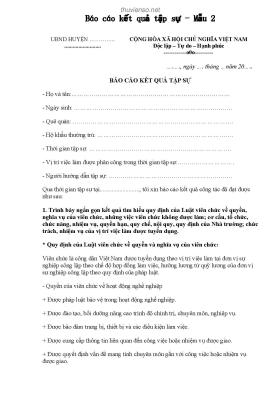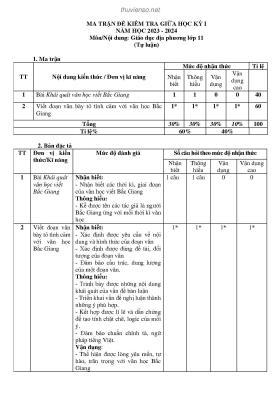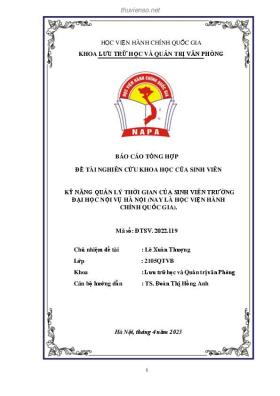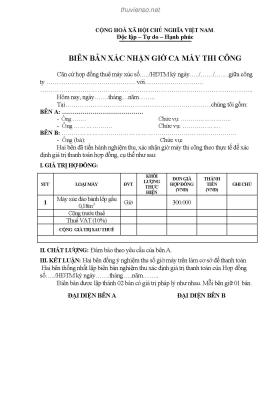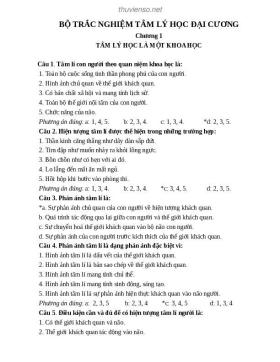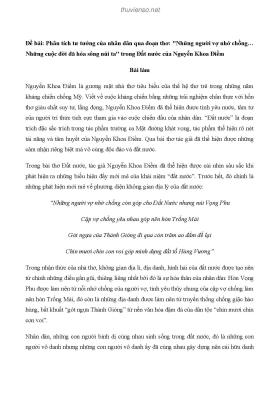
Lecture Operating system concepts (9/ed) - Chapter 2: Operating-System
Số trang: 55
Loại file: ppt
Dung lượng: 3.62 MB
Lượt xem: 11
Lượt tải: 0
Xem trước 6 trang đầu tiên của tài liệu này:
Thông tin tài liệu:
In this chapter, the following content will be discussed: Operating system services, user operating system interface, system calls, types of system calls, system programs, operating system design and implementation, operating system structure, operating system debugging, operating system generation, system boot.
Nội dung trích xuất từ tài liệu:
Lecture Operating system concepts (9/ed) - Chapter 2: Operating-System Chapter 2: Operating-System StructuresOperating System Concepts – 9th Edition Silberschatz, Galvin and Gagne ©2013 Chapter 2: Operating-System Structures Operating System Services User Operating System Interface System Calls Types of System Calls System Programs Operating System Design and Implementation Operating System Structure Operating System Debugging Operating System Generation System BootOperating System Concepts – 9th Edition 2.2 Silberschatz, Galvin and Gagne ©2013 Objectives To describe the services an operating system provides to users, processes, and other systems To discuss the various ways of structuring an operating system To explain how operating systems are installed and customized and how they bootOperating System Concepts – 9th Edition 2.3 Silberschatz, Galvin and Gagne ©2013 Operating System Services Operating systems provide an environment for execution of programs and services to programs and users One set of operating-system services provides functions that are helpful to the user: User interface - Almost all operating systems have a user interface (UI). Varies between Command-Line (CLI), Graphics User Interface (GUI), Batch Program execution - The system must be able to load a program into memory and to run that program, end execution, either normally or abnormally (indicating(cho biết) error) I/O operations - A running program may require I/O, which may involve(gồm) a file or an I/O deviceOperating System Concepts – 9th Edition 2.4 Silberschatz, Galvin and Gagne ©2013 Operating System Services (Cont.) One set of operating-system services provides functions that are helpful to the user (Cont.): File-system manipulation - The file system is of particular(đ/biệt) interest. Programs need to read and write files and directories, create and delete them, search them, list file Information, permission management. Communications – Processes may exchange(trao đổi DL) information, on the same computer or between computers over a network Communications may be via shared memory or through message passing (packets(gói tin) moved by the OS) Error detection – OS needs to be constantly(l/luôn) aware(có kiến thức, nhận thức) of possible errors May occur in the CPU and memory hardware, in I/O devices, in user program For each type of error, OS should take the appropriate action to ensure(đảm bảo) correct and consistent(nhất quán) computing Debugging facilities(p/tiện) can greatly enhance(n/cao) the user’s and programmer’s abilities(k/năng) to efficiently(h/quả) use the systemOperating System Concepts – 9th Edition 2.5 Silberschatz, Galvin and Gagne ©2013 Operating System Services (Cont.) Another set of OS functions exists for ensuring the efficient operation of the system itself via resource sharing Resource allocation - When multiple users or multiple jobs running concurrently, resources must be allocated to each of them Many types of resources - CPU cycles, main memory, file storage, I/O devices. Accounting(tính toán, giải thích) - To keep track of which users use how much and what kinds of computer resources Protection and security - The owners of information stored in a multiuser or networked computer system may want to control use of that information, concurrent processes should not interfere with each other Protection involves(gồm) ensuring(đ/bảo) that all access to system resources is controlled Se ...
Nội dung trích xuất từ tài liệu:
Lecture Operating system concepts (9/ed) - Chapter 2: Operating-System Chapter 2: Operating-System StructuresOperating System Concepts – 9th Edition Silberschatz, Galvin and Gagne ©2013 Chapter 2: Operating-System Structures Operating System Services User Operating System Interface System Calls Types of System Calls System Programs Operating System Design and Implementation Operating System Structure Operating System Debugging Operating System Generation System BootOperating System Concepts – 9th Edition 2.2 Silberschatz, Galvin and Gagne ©2013 Objectives To describe the services an operating system provides to users, processes, and other systems To discuss the various ways of structuring an operating system To explain how operating systems are installed and customized and how they bootOperating System Concepts – 9th Edition 2.3 Silberschatz, Galvin and Gagne ©2013 Operating System Services Operating systems provide an environment for execution of programs and services to programs and users One set of operating-system services provides functions that are helpful to the user: User interface - Almost all operating systems have a user interface (UI). Varies between Command-Line (CLI), Graphics User Interface (GUI), Batch Program execution - The system must be able to load a program into memory and to run that program, end execution, either normally or abnormally (indicating(cho biết) error) I/O operations - A running program may require I/O, which may involve(gồm) a file or an I/O deviceOperating System Concepts – 9th Edition 2.4 Silberschatz, Galvin and Gagne ©2013 Operating System Services (Cont.) One set of operating-system services provides functions that are helpful to the user (Cont.): File-system manipulation - The file system is of particular(đ/biệt) interest. Programs need to read and write files and directories, create and delete them, search them, list file Information, permission management. Communications – Processes may exchange(trao đổi DL) information, on the same computer or between computers over a network Communications may be via shared memory or through message passing (packets(gói tin) moved by the OS) Error detection – OS needs to be constantly(l/luôn) aware(có kiến thức, nhận thức) of possible errors May occur in the CPU and memory hardware, in I/O devices, in user program For each type of error, OS should take the appropriate action to ensure(đảm bảo) correct and consistent(nhất quán) computing Debugging facilities(p/tiện) can greatly enhance(n/cao) the user’s and programmer’s abilities(k/năng) to efficiently(h/quả) use the systemOperating System Concepts – 9th Edition 2.5 Silberschatz, Galvin and Gagne ©2013 Operating System Services (Cont.) Another set of OS functions exists for ensuring the efficient operation of the system itself via resource sharing Resource allocation - When multiple users or multiple jobs running concurrently, resources must be allocated to each of them Many types of resources - CPU cycles, main memory, file storage, I/O devices. Accounting(tính toán, giải thích) - To keep track of which users use how much and what kinds of computer resources Protection and security - The owners of information stored in a multiuser or networked computer system may want to control use of that information, concurrent processes should not interfere with each other Protection involves(gồm) ensuring(đ/bảo) that all access to system resources is controlled Se ...
Tìm kiếm theo từ khóa liên quan:
Hệ điều hành Hệ điều hành nâng cao Operating System Computer System Organization Operating System Structures Operating system servicesGợi ý tài liệu liên quan:
-
Giáo trình Lý thuyết hệ điều hành: Phần 1 - Nguyễn Kim Tuấn
110 trang 440 0 0 -
Giáo trình Nguyên lý các hệ điều hành: Phần 2
88 trang 262 0 0 -
175 trang 259 0 0
-
173 trang 257 2 0
-
Giáo trình Nguyên lý hệ điều hành (In lần thứ ba): Phần 1 - PGS.TS. Hà Quang Thụy
98 trang 235 0 0 -
Đề tài nguyên lý hệ điều hành: Nghiên cứu tìm hiểu về bộ nhớ ngoài trong hệ điều hành Linux
19 trang 234 0 0 -
Bài thảo luận nhóm: Tìm hiểu và phân tích kiến trúc, chức năng và hoạt động của hệ điều hành Android
39 trang 219 0 0 -
Giáo trình Hệ điều hành: Phần 2
53 trang 205 0 0 -
Bài giảng Nguyên lý hệ điều hành (Bài giảng tuần 3) - Nguyễn Hải Châu
8 trang 197 0 0 -
Bài thuyết trình nhóm môn Hệ điều hành: Tìm hiểu về cách quản lý tệp
17 trang 186 0 0



